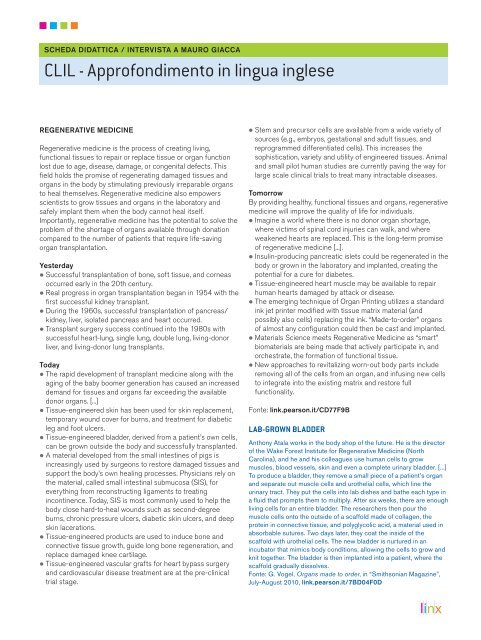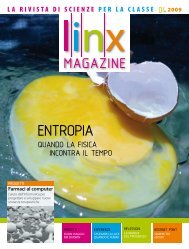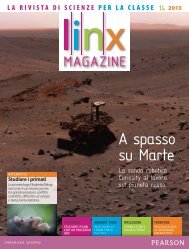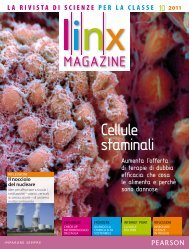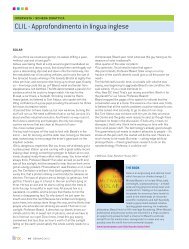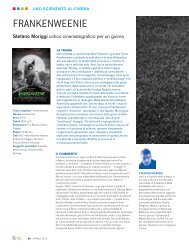Scarica la SCHEDA DIDATTICA in formato pdf - Linx Magazine
Scarica la SCHEDA DIDATTICA in formato pdf - Linx Magazine
Scarica la SCHEDA DIDATTICA in formato pdf - Linx Magazine
You also want an ePaper? Increase the reach of your titles
YUMPU automatically turns print PDFs into web optimized ePapers that Google loves.
<strong>SCHEDA</strong> <strong>DIDATTICA</strong> / INTERVISTA A MAURO GIACCA<br />
CLIL - Approfondimento <strong>in</strong> l<strong>in</strong>gua <strong>in</strong>glese<br />
REGENERATIVE MEDICINE<br />
Regenerative medic<strong>in</strong>e is the process of creat<strong>in</strong>g liv<strong>in</strong>g,<br />
functional tissues to repair or rep<strong>la</strong>ce tissue or organ function<br />
lost due to age, disease, damage, or congenital defects. This<br />
field holds the promise of regenerat<strong>in</strong>g damaged tissues and<br />
organs <strong>in</strong> the body by stimu<strong>la</strong>t<strong>in</strong>g previously irreparable organs<br />
to heal themselves. Regenerative medic<strong>in</strong>e also empowers<br />
scientists to grow tissues and organs <strong>in</strong> the <strong>la</strong>boratory and<br />
safely imp<strong>la</strong>nt them when the body cannot heal itself.<br />
Importantly, regenerative medic<strong>in</strong>e has the potential to solve the<br />
problem of the shortage of organs avai<strong>la</strong>ble through donation<br />
compared to the number of patients that require life-sav<strong>in</strong>g<br />
organ transp<strong>la</strong>ntation.<br />
Yesterday<br />
l Successful transp<strong>la</strong>ntation of bone, soft tissue, and corneas<br />
occurred early <strong>in</strong> the 20th century.<br />
l Real progress <strong>in</strong> organ transp<strong>la</strong>ntation began <strong>in</strong> 1954 with the<br />
first successful kidney transp<strong>la</strong>nt.<br />
l Dur<strong>in</strong>g the 1960s, successful transp<strong>la</strong>ntation of pancreas/<br />
kidney, liver, iso<strong>la</strong>ted pancreas and heart occurred.<br />
l Transp<strong>la</strong>nt surgery success cont<strong>in</strong>ued <strong>in</strong>to the 1980s with<br />
successful heart-lung, s<strong>in</strong>gle lung, double lung, liv<strong>in</strong>g-donor<br />
liver, and liv<strong>in</strong>g-donor lung transp<strong>la</strong>nts.<br />
Today<br />
l The rapid development of transp<strong>la</strong>nt medic<strong>in</strong>e along with the<br />
ag<strong>in</strong>g of the baby boomer generation has caused an <strong>in</strong>creased<br />
demand for tissues and organs far exceed<strong>in</strong>g the avai<strong>la</strong>ble<br />
donor organs. [...]<br />
l Tissue-eng<strong>in</strong>eered sk<strong>in</strong> has been used for sk<strong>in</strong> rep<strong>la</strong>cement,<br />
temporary wound cover for burns, and treatment for diabetic<br />
leg and foot ulcers.<br />
l Tissue-eng<strong>in</strong>eered b<strong>la</strong>dder, derived from a patient’s own cells,<br />
can be grown outside the body and successfully transp<strong>la</strong>nted.<br />
l A material developed from the small <strong>in</strong>test<strong>in</strong>es of pigs is<br />
<strong>in</strong>creas<strong>in</strong>gly used by surgeons to restore damaged tissues and<br />
support the body’s own heal<strong>in</strong>g processes. Physicians rely on<br />
the material, called small <strong>in</strong>test<strong>in</strong>al submucosa (SIS), for<br />
everyth<strong>in</strong>g from reconstruct<strong>in</strong>g ligaments to treat<strong>in</strong>g<br />
<strong>in</strong>cont<strong>in</strong>ence. Today, SIS is most commonly used to help the<br />
body close hard-to-heal wounds such as second-degree<br />
burns, chronic pressure ulcers, diabetic sk<strong>in</strong> ulcers, and deep<br />
sk<strong>in</strong> <strong>la</strong>cerations.<br />
l Tissue-eng<strong>in</strong>eered products are used to <strong>in</strong>duce bone and<br />
connective tissue growth, guide long bone regeneration, and<br />
rep<strong>la</strong>ce damaged knee carti<strong>la</strong>ge.<br />
l Tissue-eng<strong>in</strong>eered vascu<strong>la</strong>r grafts for heart bypass surgery<br />
and cardiovascu<strong>la</strong>r disease treatment are at the pre-cl<strong>in</strong>ical<br />
trial stage.<br />
l Stem and precursor cells are avai<strong>la</strong>ble from a wide variety of<br />
sources (e.g., embryos, gestational and adult tissues, and<br />
reprogrammed differentiated cells). This <strong>in</strong>creases the<br />
sophistication, variety and utility of eng<strong>in</strong>eered tissues. Animal<br />
and small pilot human studies are currently pav<strong>in</strong>g the way for<br />
<strong>la</strong>rge scale cl<strong>in</strong>ical trials to treat many <strong>in</strong>tractable diseases.<br />
Tomorrow<br />
By provid<strong>in</strong>g healthy, functional tissues and organs, regenerative<br />
medic<strong>in</strong>e will improve the quality of life for <strong>in</strong>dividuals.<br />
l Imag<strong>in</strong>e a world where there is no donor organ shortage,<br />
where victims of sp<strong>in</strong>al cord <strong>in</strong>juries can walk, and where<br />
weakened hearts are rep<strong>la</strong>ced. This is the long-term promise<br />
of regenerative medic<strong>in</strong>e [...].<br />
l Insul<strong>in</strong>-produc<strong>in</strong>g pancreatic islets could be regenerated <strong>in</strong> the<br />
body or grown <strong>in</strong> the <strong>la</strong>boratory and imp<strong>la</strong>nted, creat<strong>in</strong>g the<br />
potential for a cure for diabetes.<br />
l Tissue-eng<strong>in</strong>eered heart muscle may be avai<strong>la</strong>ble to repair<br />
human hearts damaged by attack or disease.<br />
l The emerg<strong>in</strong>g technique of Organ Pr<strong>in</strong>t<strong>in</strong>g utilizes a standard<br />
<strong>in</strong>k jet pr<strong>in</strong>ter modified with tissue matrix material (and<br />
possibly also cells) rep<strong>la</strong>c<strong>in</strong>g the <strong>in</strong>k. “Made-to-order” organs<br />
of almost any configuration could then be cast and imp<strong>la</strong>nted.<br />
l Materials Science meets Regenerative Medic<strong>in</strong>e as “smart”<br />
biomaterials are be<strong>in</strong>g made that actively participate <strong>in</strong>, and<br />
orchestrate, the formation of functional tissue.<br />
l New approaches to revitaliz<strong>in</strong>g worn-out body parts <strong>in</strong>clude<br />
remov<strong>in</strong>g all of the cells from an organ, and <strong>in</strong>fus<strong>in</strong>g new cells<br />
to <strong>in</strong>tegrate <strong>in</strong>to the exist<strong>in</strong>g matrix and restore full<br />
functionality.<br />
Fonte: l<strong>in</strong>k.pearson.it/CD77F9B<br />
LAB-GROWN BLADDER<br />
Anthony Ata<strong>la</strong> works <strong>in</strong> the body shop of the future. He is the director<br />
of the Wake Forest Institute for Regenerative Medic<strong>in</strong>e (North<br />
Carol<strong>in</strong>a), and he and his colleagues use human cells to grow<br />
muscles, blood vessels, sk<strong>in</strong> and even a complete ur<strong>in</strong>ary b<strong>la</strong>dder. [...]<br />
To produce a b<strong>la</strong>dder, they remove a small piece of a patient’s organ<br />
and separate out muscle cells and urothelial cells, which l<strong>in</strong>e the<br />
ur<strong>in</strong>ary tract. They put the cells <strong>in</strong>to <strong>la</strong>b dishes and bathe each type <strong>in</strong><br />
a fluid that prompts them to multiply. After six weeks, there are enough<br />
liv<strong>in</strong>g cells for an entire b<strong>la</strong>dder. The researchers then pour the<br />
muscle cells onto the outside of a scaffold made of col<strong>la</strong>gen, the<br />
prote<strong>in</strong> <strong>in</strong> connective tissue, and polyglycolic acid, a material used <strong>in</strong><br />
absorbable sutures. Two days <strong>la</strong>ter, they coat the <strong>in</strong>side of the<br />
scaffold with urothelial cells. The new b<strong>la</strong>dder is nurtured <strong>in</strong> an<br />
<strong>in</strong>cubator that mimics body conditions, allow<strong>in</strong>g the cells to grow and<br />
knit together. The b<strong>la</strong>dder is then imp<strong>la</strong>nted <strong>in</strong>to a patient, where the<br />
scaffold gradually dissolves.<br />
Fonte: G. Vogel, Organs made to order, <strong>in</strong> “Smithsonian Magaz<strong>in</strong>e”,<br />
July-August 2010, l<strong>in</strong>k.pearson.it/7BD04F0D
<strong>SCHEDA</strong> <strong>DIDATTICA</strong> / INTERVISTA A MAURO GIACCA<br />
Ora tocca a te<br />
DOMANDE E ATTIVITÀ<br />
1. Il cuore umano è una sofisticata “macch<strong>in</strong>a” che pompa<br />
sangue nell’apparato circo<strong>la</strong>torio. La sua efficienza è data dal<strong>la</strong><br />
netta separazione <strong>in</strong> due parti: il “cuore s<strong>in</strong>istro” sp<strong>in</strong>ge il sangue<br />
ossigenato proveniente dai polmoni all’aorta e, da qui, verso<br />
tutte le arterie di distribuzione agli organi, mentre nel “cuore<br />
destro” affluisce attraverso le vene il sangue deossigenato<br />
rientrante da tutti gli organi, che viene sp<strong>in</strong>to nuovamente ai<br />
polmoni.<br />
a. Realizza un disegno del<strong>la</strong> funzione cardiovasco<strong>la</strong>re, <strong>in</strong>dicando<br />
atri e ventricoli, circo<strong>la</strong>zioni sistemica e polmonare con arterie<br />
e vene (attenzione al<strong>la</strong> circo<strong>la</strong>zione polmonare!).<br />
b . Fai una rapida ricerca <strong>in</strong> rete per scoprire che cosa sono le<br />
vene l<strong>in</strong>fatiche e come sono connesse con <strong>la</strong> circo<strong>la</strong>zione<br />
generale.<br />
2. Nel corso dell’evoluzione il cuore ha subito rilevanti<br />
modificazioni: utilizzando lo schema proposto all’<strong>in</strong>dirizzo l<strong>in</strong>k.<br />
pearson.it/E2D91EB7, <strong>in</strong>dividua quali sono i limiti del<strong>la</strong><br />
circo<strong>la</strong>zione dei vertebrati <strong>la</strong> cui orig<strong>in</strong>e è più antica e quali<br />
miglioramenti si sono successivamente sviluppati (Figura 1).<br />
3. Ricordando che con il term<strong>in</strong>e omeotermia si <strong>in</strong>tende <strong>la</strong><br />
capacità di un organismo di rego<strong>la</strong>re <strong>la</strong> propria temperatura<br />
corporea (i cosiddetti animali a “sangue caldo”), ricostruisci <strong>in</strong> un<br />
brano s<strong>in</strong>tetico il nesso tra l’evoluzione del cuore nei vertebrati e<br />
l’opportunità di alcuni mammiferi e uccelli di vivere nei climi<br />
rigidi di <strong>la</strong>titud<strong>in</strong>i e quote elevate.<br />
Lo sai che già i più grandi d<strong>in</strong>osauri carnivori erano parzialmente<br />
omeotermi poiché dotati di un cuore a quattro camere? Conosci<br />
qualche rettile odierno che ha conservato <strong>la</strong> stessa virtù?<br />
n Figura 1<br />
ventricolo (v)<br />
atrio (a)<br />
capil<strong>la</strong>ri branchiali<br />
capil<strong>la</strong>ri sistemici<br />
a<br />
v<br />
circo<strong>la</strong>zione<br />
pneumo-cutanea<br />
a<br />
destra s<strong>in</strong>istra<br />
circo<strong>la</strong>zione<br />
sistemica<br />
capil<strong>la</strong>ri polmonari<br />
e cutanei<br />
capil<strong>la</strong>ri sistemici<br />
4. Il cuore è <strong>formato</strong> da cellule musco<strong>la</strong>ri <strong>la</strong> cui contrazione è<br />
generata dal nodo seno-atriale nell’atrio destro: esso stimo<strong>la</strong><br />
direttamente il tessuto musco<strong>la</strong>re degli atri, i quali si<br />
contraggono sp<strong>in</strong>gendo il sangue nei ventricoli; attraverso il<br />
nodo atrio-ventrico<strong>la</strong>re, <strong>in</strong>vece, fa contrarre i ventricoli con un<br />
leggero ritardo e così il sangue è sp<strong>in</strong>to verso le arterie. Il nodo<br />
seno-atriale è chiamato pacemaker e <strong>la</strong> sua attività è autonoma,<br />
anche se può essere condizionata da stimo<strong>la</strong>zioni nervose e<br />
fattori chimici.<br />
Ricercando le <strong>in</strong>formazioni sul tuo manuale sco<strong>la</strong>stico, rispondi<br />
alle seguenti domande:<br />
a. Nel corso dello sviluppo embrionale, quando si attiva <strong>la</strong><br />
funzione cardiaca?<br />
b . Quali compartimenti del sistema nervoso <strong>in</strong>nervano e<br />
modu<strong>la</strong>no l’attività del cuore? E quali ormoni lo condizionano?<br />
5. Ora prova tu: ponendo l’orecchio sul cuore di un tuo<br />
compagno dist<strong>in</strong>gui un doppio battito, corrispondente al<strong>la</strong><br />
chiusura <strong>in</strong> successione delle “porte” (valvole) di <strong>in</strong>gresso e<br />
uscita dai ventricoli. Se <strong>in</strong>vece, con il dito, <strong>in</strong>tercetti il battito<br />
lungo l’arteria del tuo collo (<strong>la</strong> carotide) avverti un segnale<br />
s<strong>in</strong>golo, dovuto al<strong>la</strong> so<strong>la</strong> pressione ritmata <strong>in</strong> uscita dal<br />
ventricolo s<strong>in</strong>istro.<br />
6. Le cellule contrattili del cuore ricevono il loro nutrimento<br />
(ossigeno e zuccheri) non attraverso <strong>la</strong> circo<strong>la</strong>zione <strong>in</strong>terna<br />
atrio-ventrico<strong>la</strong>re ma da una ramificata rete di arterie – le<br />
coronarie – che avvolgono il cuore ramificandosi <strong>in</strong> profondità<br />
nel tessuto.<br />
Se il flusso coronarico di un settore è impedito (ischemia), le<br />
cellule cardiache a valle vengono irrimediabilmente danneggiate<br />
e, <strong>in</strong>f<strong>in</strong>e, muoiono (necrosi); si riduce così <strong>la</strong> funzionalità del<br />
cuore, che manifesta <strong>in</strong>capacità (<strong>in</strong>sufficienza) anche grave<br />
(scompenso) a far circo<strong>la</strong>re nel corpo <strong>in</strong> modo<br />
adeguato il sangue.<br />
Fai una ricerca <strong>in</strong> rete su quali<br />
fattori predispongano all’<strong>in</strong>farto<br />
e su quali strategie<br />
a<br />
v<br />
circo<strong>la</strong>zione<br />
polmonare<br />
a<br />
v<br />
destra s<strong>in</strong>istra<br />
circo<strong>la</strong>zione<br />
sistemica<br />
capil<strong>la</strong>ri polmonari<br />
capil<strong>la</strong>ri sistemici<br />
preventive, sia <strong>in</strong>dividuali<br />
sia collettive, debbano<br />
essere sostenute.


